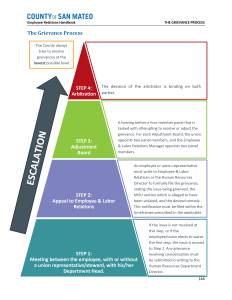 A grievance can be loosely defined as any concern or complaint raised by an employee. In this context, concerns/complaints may be raised about a wide variety of issues, such as building temperature, workload, or denial of a requested change in assignment or location. Supervisors should give a fair hearing to employees raising such complaints, and, if appropriate, discuss possible resolutions with their managers. Listening to and attempting to promptly resolve employee complaints is an essential step in maintaining high morale and positive employee-supervisory relations. In order to feel part of a productive team, employees need to know that they can raise concerns/complaints without fear of reprisal, and that their concerns/complaints will be heard and given full consideration.
A grievance can be loosely defined as any concern or complaint raised by an employee. In this context, concerns/complaints may be raised about a wide variety of issues, such as building temperature, workload, or denial of a requested change in assignment or location. Supervisors should give a fair hearing to employees raising such complaints, and, if appropriate, discuss possible resolutions with their managers. Listening to and attempting to promptly resolve employee complaints is an essential step in maintaining high morale and positive employee-supervisory relations. In order to feel part of a productive team, employees need to know that they can raise concerns/complaints without fear of reprisal, and that their concerns/complaints will be heard and given full consideration.
The informal “grievances” described above are not covered by the negotiated grievance process. In order for a grievance to be filed and processed under the provisions of the negotiated grievance process, the grievance must allege that a provision of the MOU was violated. This Section discusses the formal negotiated grievance process. The Memoranda of Understanding covering represented employees, and can be accessed at http://hr.smcgov.org/memorandum-understanding-mou .
